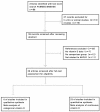Association between vitamin D and non-alcoholic fatty liver disease/non-alcoholic steatohepatitis: results from a meta-analysis
- PMID: 26770315
- PMCID: PMC4694215
Association between vitamin D and non-alcoholic fatty liver disease/non-alcoholic steatohepatitis: results from a meta-analysis
Abstract
The prevalence and impact of non-alcoholic fatty liver disease (NAFLD) and non-alcoholic steatohepatitis (NASH) have continued to increase in recent years. Previous reports have shown that hypovitaminosis D is associated with the prevalence and severity of non-alcoholic fatty liver disease (NAFLD). The aim of this study was to systematically evaluate the association of vitamin D levels, as measured by serum 25-hydroxy vitamin D [25(OH)D], with NAFLD and NASH. We searched all of the publications that assessed the association between vitamin D and NAFLD/NASH in the PubMed and EMBASE databases up to November 2014. In total, twenty-nine articles met the eligibility criteria, including twenty-seven studies about NAFLD and four studies about NASH, which were identified and included in the meta-analysis. Twenty-nine cross-sectional and case-control studies evaluated the association between vitamin D and NAFLD/NASH. Twenty-three studies provided data for a quantitative meta-analysis. Compared with the controls, the NAFLD patients had significantly lower levels of 25(OH)D (SMD-0.76; 95% CI-0.97 to-0.54) and were 1.26 times more likely to be vitamin D deficient (OR 1.26, 95% CI: 1.15 to 1.38). Compared with the controls, the NASH patients had significantly lower levels of 25(OH)D (SMD-1.30; 95% CI-2.37 to -0.23). Although the cross-sectional studies did not allow us to determine a causal nexus, our meta-analysis found lower serum 25(OH)D levels in NAFLD/NASH patients than in subjects without NAFLD/NASH, which suggests that hypovitaminosis D could play a role in the pathogenesis of NAFLD/NASH. Further studies are required to establish the causality between vitamin D status and NAFLD.
Keywords: Non-alcoholic steatohepatitis; meta-analysis; non-alcoholic fatty liver disease; vitamin D.
Figures








References
-
- Wieckowska A, McCullough AJ, Feldstein AE. Noninvasive diagnosis and monitoring of nonalcoholic steatohepatitis: present and future. Hepatology. 2007;46:582–589. - PubMed
-
- Chalasani N, Younossi Z, Lavine JE, Diehl AM, Brunt EM, Cusi K, Charlton M, Sanyal AJ American Gastroenterological Association; American Association for the Study of Liver Diseases; American College of Gastroenterologyh. The diagnosis and management of non-alcoholic fatty liver disease: practice guideline by the American Gastroenterological Association, American Association for the Study of Liver Diseases, and American College of Gastroenterology. Gastroenterology. 2012;142:1592–1609. - PubMed
-
- Ascha MS, Hanouneh IA, Lopez R, Tamimi TA, Feldstein AF, Zein NN. The incidence and risk factors of hepatocellular carcinoma in patients with nonalcoholic steatohepatitis. Hepatology. 2010;51:1972–1978. - PubMed
-
- Bhala N, Angulo P, van der Poorten D, Lee E, Hui JM, Saracco G, Adams LA, Charatcharoenwitthaya P, Topping JH, Bugianesi E, Day CP, George J. The natural history of nonalcoholic fatty liver disease with advanced fibrosis or cirrhosis: an international collaborative study. Hepatology. 2011;54:1208–1216. - PMC - PubMed
-
- Wong VW, Wong GL, Choi PC, Chan AW, Li MK, Chan HY, Chim AM, Yu J, Sung JJ, Chan HL. Disease progression of non-alcoholic fatty liver disease: a prospective study with paired liver biopsies at 3 years. Gut. 2010;59:969–974. - PubMed
LinkOut - more resources
Full Text Sources
Miscellaneous
